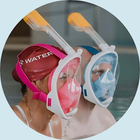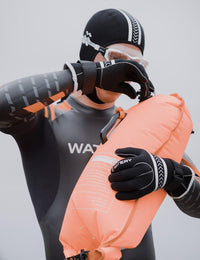There are countless options and activities that can fill your time, including swimming, school, parties, café visits, holidays, birthdays, and more. However, no matter how much you'd like, a day still only has 24 hours. For many, those 24 hours aren't enough to cover swimming and school alone.
To help YOU manage your day-to-day activities and make the most of your 24 hours, we've put together a 4-step guide here at Watery. This guide will help you stay focused on the process and achieve your goals without succumbing to those tough days!
GET A DISCOUNT CODE WITH 10% OFF
The discount code can be used by all new customers on all products on the website, including the products recommended here in the article.
What are you waiting for? Get more out of your time in and on the water!
STEP 1: Accept
The first phase sounds far simpler than it is in practice. Acceptance begins with acknowledging that as a swimmer, you can't do EVERYTHING and can only be in one place at a time. Sometimes you might manage to train on Friday evening and then attend a school party, but accepting the consequences of attending the party is crucial. There’s nothing wrong with participating in school parties and other events now and again, but every choice has consequences, and recognizing this is incredibly important as a swimmer.
Once you accept that your time is limited, it becomes easier to decide where, how, and with whom you want to spend your time. There's absolutely no right or wrong answer to how you should allocate your time—your club might have some guidelines—but the rest is entirely up to you as a whole person.
STEP 2: Align and Prioritize (set a goal)
The second phase is both the easiest and the hardest at the same time. This phase involves deciding what your goals are as a swimmer, and how to prioritize your time to achieve them, now that you've accepted that the day only has 24 hours. A goal might be a qualifying time for a specific meet, a finals spot, achieving a certain time in a particular race, a national championship, etc. Goals can also include better recovery, improved core strength, increased training attendance, etc. While we don't want to crush dreams, it’s important in this phase to reconcile with the fact that not all goals are achievable (even though an Olympic gold medal sounds amazing!). To make your goals more manageable, set time frames on when you want to achieve them. Personally, I've found it most effective when I have both long-term and short-term goals, with the deadline within half a year. Having goals is not just crucial for prioritizing your time; a goal can also lift you and boost motivation on dark days when neither body nor mind cooperates—it's the big picture that's exciting!
4.7/5
Based on 99 reviews

Watery Elite swim goggles - Poseidon Ultra Mirror - Dark blue/gold
Besides aligning your goals with yourself, it's also vital to involve your coach (and family if you live at home) in your visions for the future (whether short-term or long-term). This way, your environment can support you on your journey toward your goal. Additionally, I can guarantee it’s a massive boost to give your surroundings insight and understanding into what you’re spending most of your free time on!
Note: Write down your goals!
STEP 3: Make a Plan
Once you’ve set a goal, it’s time to make a plan. It’s also a good idea to involve both your coach and family here. The plan should consist of guidelines that you need to meet to achieve your goal. These guidelines could include weekly training sessions, a personal meet schedule, a meal plan, etc. When you have a plan, share it with your family and friends, and agree on which events you can attend (and which you can’t)—you might even adapt a few events to fit your plan?
Having a wholehearted plan makes it much easier to stay on track and manage your time. With such a plan, you’ll quickly form habits. Habits are extremely important (assuming they’re good ones, of course), especially on the tough days or days when your arms feel like concrete. With habits, you'll quickly learn what works best for you, and how to optimize these habits to get the most out of your hard work! Also, always have your swim goggles ready, so you're prepared for every training session and competition.
STEP 4: Stick to the Plan
Even when it’s gray and gloomy at times, it’s important to stay focused on the process. Although the great days, where the whole body is functioning and you're almost flying over the water, unfortunately, these days never make up the majority of your training sessions...
It's also crucial not to go out every Friday if your plan schedules a tough pace workout for Saturday morning. That said, there's nothing wrong with having fun, but everything in moderation. Plus, your plan should provide you with an overview of when and during which periods it’s most appropriate "to have fun," whatever that may involve—the obvious suggestion; summer vacation.
When following the plan, it’s also important not to get discouraged if you don't achieve your goals despite all your hard work! Remember, winners aren't those who never fail, but those who never give up.
By going through these phases, you'll learn much more about yourself as both a person and a swimmer, and (hopefully) gain more balance in your daily life.
Watery wishes you a great start to the season and a continued wonderful summer!
























